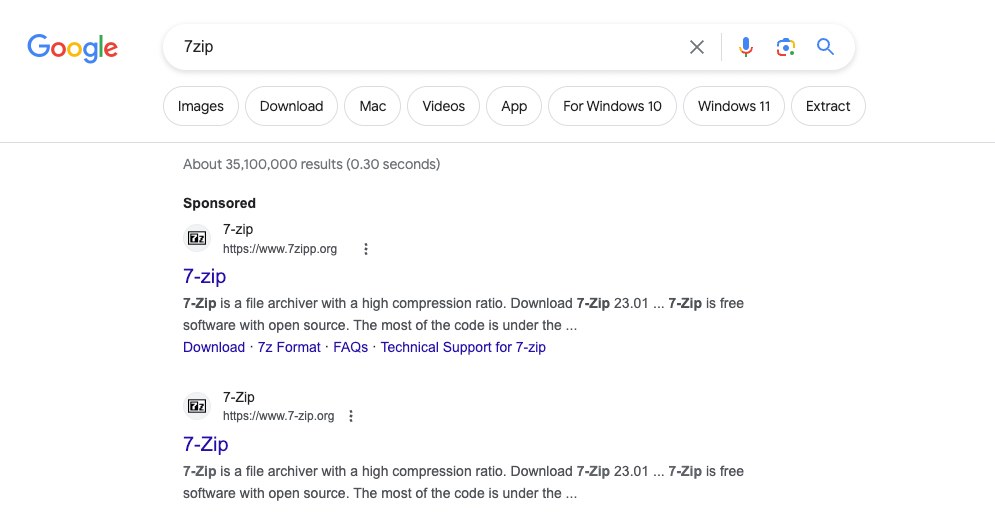# PLATFORM . THM# CTF NAME . Hunt Me II: Typo Squatters# DESCRIPTION . One of your software developers unknowingly installed a malicious software. Can you trace back the root cause?# DIFFICULTY . Medium# CTF LINK . https://tryhackme.com/r/room/typosquattersJust working on a typical day as a software engineer, Perry received an encrypted 7z archive from his boss containing a snippet of a source code that must be completed within the day. Realising that his current workstation does not have an application that can unpack the file, he spins up his browser and starts to search for software that can aid in accessing the file. Without validating the resource, Perry immediately clicks the first search engine result and installs the application.

Last September 26, 2023, one of the security analysts observed something unusual on the workstation owned by Perry based on the generated endpoint and network logs. Given this, your SOC lead has assigned you to conduct an in-depth investigation on this workstation and assess the impact of the potential compromise.
What is the URL of the malicious software that was downloaded by the victim user?
Section titled “What is the URL of the malicious software that was downloaded by the victim user?”- From the scenario, we see that the user used the browser to download the file
http* and process.name: chrome.exe- Then I’ve filtered after Sysmon event ID 15 to check downloaded files, as the result above didn’t provide network details.
process.name: chrome.exe and event.code: 15- Check the
winlog.event_data.Contentsfield.
What is the IP address of the domain hosting the malware?
Section titled “What is the IP address of the domain hosting the malware?”event.code: 22- If we add the
dns.resolved_ipanddns.question_namefields, we can see that the206.189.34.218ip is mapped to7zipp.org
What is the PID of the process that executed the malicious software?
Section titled “What is the PID of the process that executed the malicious software?”"7z2301-x64.msi" and event.code: 1- Add the
process.pidfield.
Following the execution chain of the malicious payload, another remote file was downloaded and executed. What is the full command line value of this suspicious activity?
Section titled “Following the execution chain of the malicious payload, another remote file was downloaded and executed. What is the full command line value of this suspicious activity?”"http*" and process.name: 'powershell.exe'The newly downloaded script also installed the legitimate version of the application. What is the full file path of the legitimate installer?
Section titled “The newly downloaded script also installed the legitimate version of the application. What is the full file path of the legitimate installer?”file.path: * and process.name: 'powershell.exe'What is the name of the service that was installed?
Section titled “What is the name of the service that was installed?”event.code: 1 and 7z*- Assuming it was related to 7zip and it’s a service… so I’ve checked process creation logs.
The attacker was able to establish a C2 connection after starting the implanted service. What is the username of the account that executed the service?
Section titled “The attacker was able to establish a C2 connection after starting the implanted service. What is the username of the account that executed the service?”- Answered from the SS above. Take a look at the username.
After dumping LSASS data, the attacker attempted to parse the data to harvest the credentials. What is the name of the tool used by the attacker in this activity?
Section titled “After dumping LSASS data, the attacker attempted to parse the data to harvest the credentials. What is the name of the tool used by the attacker in this activity?”*lsass.dmp*What is the credential pair that the attacker leveraged after the credential dumping activity? (format: username:hash)
Section titled “What is the credential pair that the attacker leveraged after the credential dumping activity? (format: username:hash)”event.code: 1 and host.name: "WKSTN-03*"After gaining access to the new account, the attacker attempted to reset the credentials of another user. What is the new password set to this target account?
Section titled “After gaining access to the new account, the attacker attempted to reset the credentials of another user. What is the new password set to this target account?”- Same query as above, just look through the logs.
What is the name of the workstation where the new account was used?
Section titled “What is the name of the workstation where the new account was used?”user.name: anna*- Filter by her name and take a look at the workstation name :)
After gaining access to the new workstation, a new set of credentials was discovered. What is the username, including its domain, and password of this new account?
Section titled “After gaining access to the new workstation, a new set of credentials was discovered. What is the username, including its domain, and password of this new account?”event.code: 1 and host.name: "WKSTN-02*"Aside from mimikatz, what is the name of the PowerShell script used to dump the hash of the domain admin?
Section titled “Aside from mimikatz, what is the name of the PowerShell script used to dump the hash of the domain admin?”event.code: 1 and *ps1*What is the AES256 hash of the domain admin based on the credential dumping output?
Section titled “What is the AES256 hash of the domain admin based on the credential dumping output?”"*Invoke-SharpKatz*" and "*hall*"After gaining domain admin access, the attacker popped ransomware on workstations. How many files were encrypted on all workstations?
Section titled “After gaining domain admin access, the attacker popped ransomware on workstations. How many files were encrypted on all workstations?”bomb.exe AND winlog.event_id:11